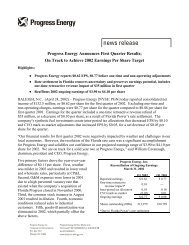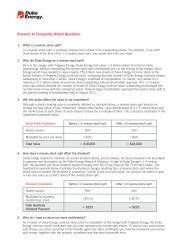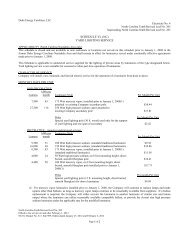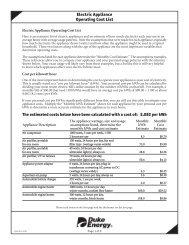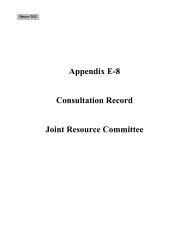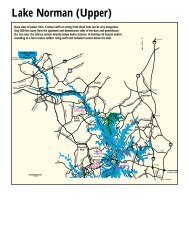3-Phase Padmount Transformer Concrete Foundation - Duke Energy
3-Phase Padmount Transformer Concrete Foundation - Duke Energy
3-Phase Padmount Transformer Concrete Foundation - Duke Energy
You also want an ePaper? Increase the reach of your titles
YUMPU automatically turns print PDFs into web optimized ePapers that Google loves.
Flat Pad and Pit Pad Application and Construction<br />
The information contained in this document has been prepared to assist both <strong>Duke</strong><br />
<strong>Energy</strong> personnel and <strong>Duke</strong> <strong>Energy</strong> customers in the application and construction of<br />
foundations for all 3-phase padmount transformers. This information is intended to<br />
provide clear distinctions between the responsibilities of <strong>Duke</strong> <strong>Energy</strong> and of the<br />
customer. However, in all cases, it is critical to maintain an open dialog between <strong>Duke</strong><br />
<strong>Energy</strong> and the customer regarding conductor quantities, conduit sizes and locations,<br />
connections, and electrical load requirements. This will ensure that the proper<br />
dimensions are used for the concrete transformer foundation.<br />
The “Pit Pad” is preferred for all 3-phase padmount installations. In cases where there<br />
are 3 secondary conductors per phase or fewer AND the conductors are less than or<br />
equal to 400 MCM, a “flat pad” may be considered. The <strong>Duke</strong> <strong>Energy</strong> project<br />
coordinator will make the final decision whether it is permissible to use a “flat pad.”<br />
A separate secondary bus enclosure is required whenever the customer is installing<br />
more than ten (10) 600 MCM or smaller conductors per phase, or more than eight (8)<br />
conductors per phase that are larger than 600 MCM.<br />
Generally, the “SMALL” pad is used for transformers rated 300 KVA and below, and the<br />
“LARGE” pad is used for transformers rated 500 KVA and above. Consider a “LARGE”<br />
pad in applications where the number of customer conduits/conductors exceeds the<br />
window opening restrictions of the “SMALL” pad, and when load growth and/or a<br />
transformer change-out to a larger size is anticipated. In most cases, regardless of the<br />
KVA rating, the air compartment of all currently purchased transformers should cover<br />
the entire window opening of either pad. (There may be some rare exceptions.)<br />
Customer Responsibilities<br />
The customer may choose to construct the transformer pad on site or purchase a<br />
prefabricated unit from a manufacturer. In either case, the customer is responsible for<br />
assuring the pad is manufactured to the requirements provided in this specification.<br />
Listed below are instructions for building a transformer pad on site.<br />
1. Customer is to contact <strong>Duke</strong> <strong>Energy</strong> to inspect pad forms and dimensions prior to<br />
concrete being poured<br />
2. Customer shall supply the concrete mix (as shown in the concrete mix<br />
specifications), welded wire fabric, #4 reinforcing bars, and shall pour the "flat pad"<br />
or "pit pad".<br />
3. The dimensions shall be in accordance with the specifications based on the<br />
transformer KVA size. The thickness of all walls on the "pit pad" shall be a minimum<br />
of 5 - 1/2” thick. The transformer KVA Size is to be specified by <strong>Duke</strong> <strong>Energy</strong>.<br />
<strong>Duke</strong> <strong>Energy</strong> 3-<strong>Phase</strong> <strong>Padmount</strong> <strong>Transformer</strong> <strong>Concrete</strong> <strong>Foundation</strong> Specifications July 2009<br />
1




